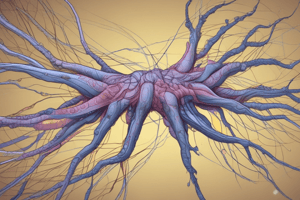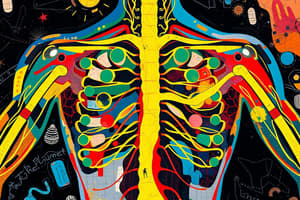Podcast
Questions and Answers
What is the primary function of the blood-brain barrier in the mammalian nervous system?
What is the primary function of the blood-brain barrier in the mammalian nervous system?
The primary function of the blood-brain barrier is to restrict the passage of certain substances into the brain.
What are the three main parts of the brain, and what are their respective functions?
What are the three main parts of the brain, and what are their respective functions?
The three main parts of the brain are the cerebrum, cerebellum, and brainstem. The cerebrum processes sensory information, controls movement, and manages higher-level cognitive functions. The cerebellum coordinates muscle movements and maintains posture and balance. The brainstem regulates basic functions such as breathing, heart rate, and blood pressure.
What type of neurons transmit information from sensory receptors to the CNS?
What type of neurons transmit information from sensory receptors to the CNS?
Sensory neurons transmit information from sensory receptors to the CNS.
What is the main difference between the Central Nervous System (CNS) and the Peripheral Nervous System (PNS)?
What is the main difference between the Central Nervous System (CNS) and the Peripheral Nervous System (PNS)?
What is the primary function of the CNS in the mammalian nervous system?
What is the primary function of the CNS in the mammalian nervous system?
What is the primary function of interneurons in the PNS?
What is the primary function of interneurons in the PNS?
What is the main function of motor control in the nervous system?
What is the main function of motor control in the nervous system?
What is the primary role of neuroglial cells in the nervous system?
What is the primary role of neuroglial cells in the nervous system?
What is the primary function of the regulation aspect of the nervous system?
What is the primary function of the regulation aspect of the nervous system?
What is the primary function of cognitive functions in the nervous system?
What is the primary function of cognitive functions in the nervous system?
Flashcards are hidden until you start studying
Study Notes
Overview of the Mammalian Nervous System
- The mammalian nervous system is a complex system that enables mammals to perceive, process, and respond to information from their environment.
- It is divided into two main parts: the Central Nervous System (CNS) and the Peripheral Nervous System (PNS).
Central Nervous System (CNS)
- The CNS consists of the brain and spinal cord.
- The brain is protected by the blood-brain barrier, a specialized barrier that restricts the passage of certain substances into the brain.
- The CNS integrates and processes information from sensory receptors and sends responses to muscles and glands.
Brain
- The brain is divided into three main parts: cerebrum, cerebellum, and brainstem.
- The cerebrum is the largest part of the brain and is responsible for processing sensory information, controlling movement, and managing higher-level cognitive functions such as thought, emotion, and memory.
- The cerebellum is involved in coordinating muscle movements and maintaining posture and balance.
- The brainstem connects the brain to the spinal cord and regulates basic functions such as breathing, heart rate, and blood pressure.
Peripheral Nervous System (PNS)
- The PNS consists of sensory neurons, motor neurons, and interneurons.
- Sensory neurons transmit information from sensory receptors to the CNS.
- Motor neurons transmit signals from the CNS to muscles and glands.
- Interneurons integrate and process information within the PNS.
Functions of the Nervous System
- Sensation: detects and interprets sensory information from the environment.
- Motor control: controls muscle movements and responses to stimuli.
- Regulation: regulates various bodily functions such as heart rate, blood pressure, and body temperature.
- Cognitive functions: enables higher-level cognitive functions such as thought, emotion, and memory.
Neuroglial Cells
- Neuroglial cells provide support and maintenance functions for neurons.
- There are several types of neuroglial cells, including astrocytes, oligodendrocytes, and microglia.
- Neuroglial cells outnumber neurons in the nervous system and play a crucial role in maintaining neuronal health and function.
Studying That Suits You
Use AI to generate personalized quizzes and flashcards to suit your learning preferences.




